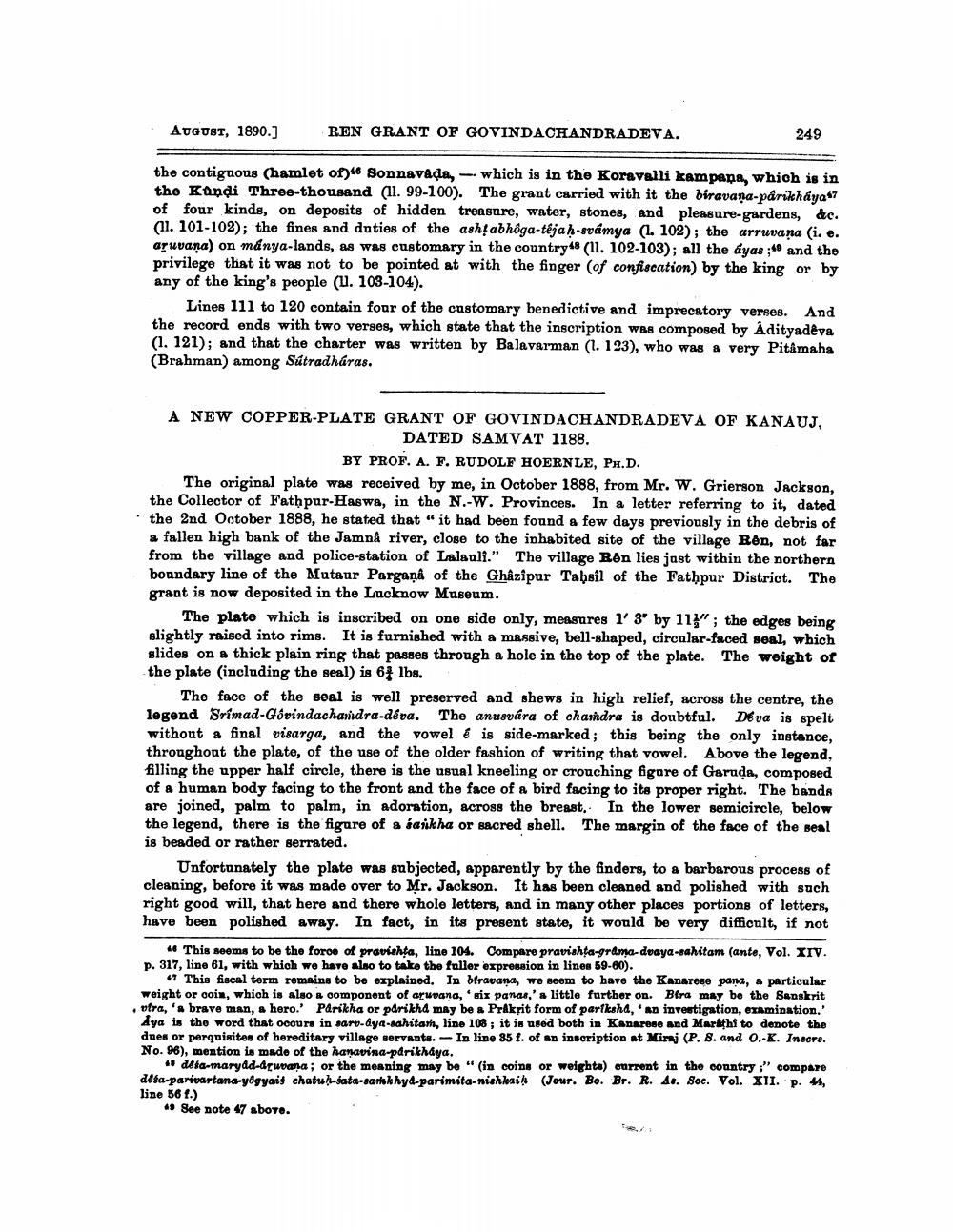________________
AUGUST, 1890.)
REN GRANT OF GOVINDACHANDRADEVA.
249
the contiguous (hamlet of)4 Sonnavada, - which is in the Koravalli kampana, which is in the Kandi Three-thousand (II. 99-100). The grant carried with it the biravana-pârikhaya67 of four kinds, on deposits of hidden treasure, water, stones, and pleasure-gardens, &c. (11. 101-102); the fines and duties of the ashțabhôga-tējah-svámya (1 102); the arruvana (i. e. aruvana) on manya-lands, as was customary in the country8 (11. 102-103); all the lyas ; and the privilege that it was not to be pointed at with the finger (of confiscation) by the king or by any of the king's people (u. 103-104).
Lines 111 to 120 contain four of the customary benedictive and imprecatory verses. And the record ends with two verses, which state that the inscription was composed by Adityadeva (1. 121); and that the charter was written by Balavarman (1. 123), who was a very Pitamaha (Brahman) among Sátradháras.
A NEW COPPER-PLATE GRANT OF GOVINDACHANDRADEVA OF KANAUJ,
DATED SAMVAT 1188.
BY PROF. A. F. RUDOLF HOERNLE, PH.D. The original plate was received by me, in October 1888, from Mr. W. Grierson Jackson, the Collector of Fathpur-Haswa, in the N.-W. Provinces. In a letter referring to it, dated the 2nd October 1888, he stated that it had been found a few days previously in the debris of a fallen high bank of the Jamná river, close to the inhabited site of the village Bén, not far from the village and police-station of Lalanli.” The village Ben lies jast within the northern boundary line of the Mutaur Pargana of the Ghazipur Tabsil of the Fathpur District. The grant is now deposited in the Lucknow Museum.
The plate which is inscribed on one side only, measures 1' 3' by 11}"; the edges being slightly raised into rims. It is furnished with a massive, bell-shaped, circular-faced seal, which slides on a thick plain ring that passes through a hole in the top of the plate. The weight of the plate (including the seal) is 64 lbs.
The face of the seal is well preserved and shews in high relief, across the centre, the legend Srimad-Govindachandra-deva. The anusvára of chandra is doubtful. Deva is spelt without a final visarga, and the vowel é is side-marked; this being the only instance, throughout the plate, of the use of the older fashion of writing that vowel. Above the legend, filling the upper half circle, there is the usual kneeling or crouching figure of Garuda, composed of a human body facing to the front and the face of a bird facing to its proper right. The bands are joined, palm to palm, in adoration, across the breast. In the lower semicircle, below the legend, there is the figure of a saikha or sacred shell. The margin of the face of the seal is beaded or rather serrated.
Unfortunately the plate was subjected, apparently by the finders, to a barbarous process of cleaning, before it was made over to Mr. Jackson. It has been cleaned and polished with such right good will, that here and there whole letters, and in many other places portions of letters, have been polished away. In fact, in its present state, it would be very difficult, if not
46 This seems to be the force of provishta, line 104. Compare pravishta-grama duaya-cahitam (ante, Vol. XIV. p. 317, line 61, with which we have also to take the fuller expression in lines 59-60).
67 This fiscal term remains to be explained. In bfrapan, we seem to have the Kanarose pana, particular weight or coin, which is also a component of arwana, 'six panas,' a little further on. Bfra may be the Sanskrit otra, 'brave man, a hero.' Parikha or parikhd may be a Prakrit form of pariksha, an investigation, examination, Aya is the word that occurs in sarı-aya-sahitan, line 108; it is used both in Kanarose and Marathi to denote the dues or perquisites of hereditary village servanta. - In line 85 f. of an inscription at Miri (P. 8. and 0.-K. Inacre. No. 96), mention is made of the hanavina-parikhaya.
+data-marydd-druvana; or the meaning may be "(in coins or weighta) current in the country;" compare disa-parivartana-yogyait chatu-sata-sarkhyd-parimita-nishini (Jour. B. Br. R. 4. Soc. Vol. XII. p. 4, line 56 f.)
* See note 47 above.




